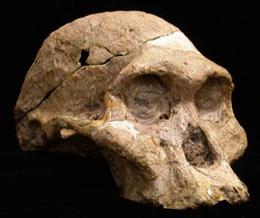摘要:怎样估计已灭绝物种的活动范围及土地利用习惯?一种方法是,测量牙齿化石中的锶同位素含量,因为锶同位素比是动物在其一生中所饮水的来源的一个很好的指 示。这个“水印”是由地质基础决定的。对来自南非的“非洲南方古猿”(Australopithecus africanus)和“罗百氏傍人”(Paranthropus robustus)的标本所做的一项锶同位素研究表明,较小的个体(推断为雌性)活动范围要大于雄性。这表明,雌性倾向于离开其原始类群并加入其他类群, 而雄性则倾向于呆在家里。这是人类和黑猩猩的一个行为特点,但不是大多数大猩猩和其他灵长类的行为特点。
由德国、美国和英国研究者组成的科考小组,在6月2日出版的新一期英国《自然》周刊上报告说,该小组对南非两个山洞中出土的一些南方古猿化石进行了分析,重点研究其牙齿化石中的锶同位素含量。
一些幼年动物的牙齿在生长时会摄入当地环境中的锶,因此其含量特征是由幼年所处地域决定的。不同地域环境中的锶同位素含量特征并不一样,可以由此判断牙齿化石所属者是从小就生活在化石出土地,还是从“他乡”迁移至此。
分析结果显示,在这两个山洞的南方古猿当中,约90%的男性成员是从小生活在当地,而女性中超过半数来自外地,可以推断是“出嫁”过来的。
南方古猿是人类早期远祖,本次研究中所用的化石测年结果在约200万年前。参与研究的英国牛津大学教授朱丽叶·李-索普教授说,研究者对南方古猿的社会特征一直了解不多,本次研究提供了难得的直接证据,有助于探索远古人类先祖的若干生活特性。
生物探索推荐英文原文:

南方古猿Africanus 的头骨
Fossilized teeth of early human ancestors bear signs that females left their families when they came of age, whereas males stayed close to home.
A chemical analysis of australopithecine fossils ranging between roughly 1.8 million and 2.2 million years old from two South African caves finds that teeth thought to belong to females are more likely to have incorporated minerals from a distant region during formation than those from males.
"What that's telling us is that the females grew up somewhere else and they died in the caves," says Julia Lee-Thorp, an archaeological scientist at the University of Oxford, UK, and a co-author on the study, published today in Nature1. "It's a very small clue, but it's something that is at least hard evidence for what we really didn't have before."
The shape of ancient human families has been the subject of speculation, based mainly on differences in the relative size of male and female fossils, and the behavioural patterns of our primate relatives. Female chimpanzees, for instance, typically leave their social group once they hit maturity. Among gorilla groups, which are dominated by one large male 'silverback', both males and females tend to strike out.
Modern humans, who are influenced by relatively recent cultural practices such as marriage and property ownership, are difficult to compare to our early ancestors, lead author Sandi Copeland of the University of Colorado at Boulder said in a press briefing.
Forensic dentistry
Lee-Thorp and her colleagues measured the levels of two isotopes of strontium, an element found in soil. This is taken up by plants and then snakes its way up the food chain into the growing bones of animals. The ratio of two strontium isotopes in bones or teeth provides a signature of the local environment in which an animal grew up, Lee-Thorp says. "It's a kind of forensic tool."
Her team measured the strontium isotope ratios in canine and third molar teeth — which are formed by about the age of eight — in eleven Paranthropus robustus individuals from the Swartkrans cave, as well as in teeth from eight Australopithecus africanus individuals from the nearby Sterkfontein cave, about 50 kilometres northwest of Johannesburg. The researchers also measured the strontium in 170 plants and animals currently living near the caves to get a sense of the different strontium signatures of the region, including the thin Malmani dolomite formation that includes both caves.
They discovered that larger teeth — ostensibly from bigger-bodied males — of both species were much more likely to share the strontium signature of dolomite-dwellers than the smaller teeth of female australopiths. About 90% of the larger teeth looked local, compared with less than half of the smaller teeth. The best explanation for this pattern is one in which females left their clan once they reached maturity, say Lee-Thorp and her colleagues.
Alternatively, males could also have left their home groups, but stuck to the band of dolomite that extends to the northeast and southwest of the two caves, she says.
Gorillas in the mists of time
"I must say that the hypothesis is interesting," says Jacopo Moggi-Cecchi, a palaeoanthropologist at the University of Florence in Italy, "but I think the numbers and the samples that they have are not large enough to prove it." Moggi-Cecchi's team reported in 2007 that P. robustus males develop over a longer period than females, a pattern echoing that seen in gorillas, in which large males fight for near-exclusive access to females2.
However, Owen Lovejoy, an anatomist at Kent State University in Ohio, says that a gorilla-like society, in which both males and females join new social groups, wouldn't have worked for early human ancestors. New males are likely to turn aggressive once they join a new group, risking the lives of infants and juveniles, he says. A society in which females left their homes is much more likely for early human ancestors, he says.
Lee-Thorp says that her team would like to get its hands on more australopithecine fossils from South Africa, but the destructive nature of the strontium tests and the paucity of fossils make that unlikely. Her team is also interested in asking similar questions about human ancestors from East Africa, as well as later species of hominin, such as _Homo erectus.







